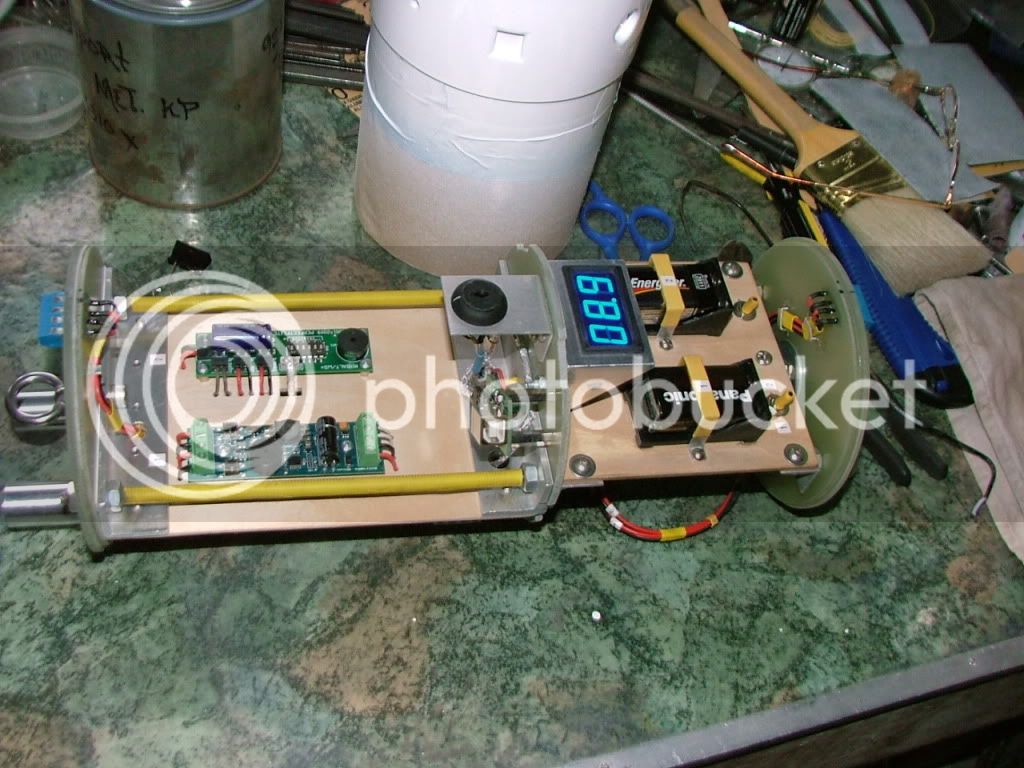exprditer789
Well-Known Member
- Joined
- Feb 11, 2010
- Messages
- 290
- Reaction score
- 0
What wire do you perfer when wiring an E-Bay.Whats the best switch to use and how do you hook that up to the altimeter?Alex

I like to use 24 AWG stranded wire, be sure to tin the ends.
OCYMMV
Or you COULD tuck it back through the vent hole into the avbay..But, taping to the side of the rocket makes disarming a lot easier if you have a misfire or ignition problem with the motor...:2:
I like Dave's post except that the forum had a big discussion a month ago about tinning the ends of stranded wire being a no-no. For "good connectors" (that have a leaf spring) you just leave the twisted wire ends bare. If the screw itself contacts the wires then you crimp on a ferrule.
I also encourage people to double-check the altimeter instructions as they often have wiring instructions. Both what the connections do and what wire is recommended.
I like the missileworks switches and have used them a lot. But I miss having a "remove before flight" lanyard.
For altimeters that include a capacitor onboard to "debounce" the power switch, I'm thinking about heading back to a headphone jack and using the NC connection for the switch input. The argument against those is that the spring contact can "bounce" but if the altimeter is protected against that then you should be fine.
I've only had the twist & tape method cause me problems once. At Sweaty Balls II, I twisted and taped on a bay held in with plastic rivets.
On the way up, the rivets fell out (I had used them before without a problem) allowing the bay to slide, and shear the wires when the apogee charge fired.
-Kevin
... Always use solid wire (or tin any stranded wire ends with solder) the loose strands in untinned stranded wire can escape during wire insertion and make contact with adjacent terminals."
This was clipped out of the Perfectflite MAWD manual..
For altimeters that include a capacitor onboard to "debounce" the power switch, I'm thinking about heading back to a headphone jack and using the NC connection for the switch input. The argument against those is that the spring contact can "bounce" but if the altimeter is protected against that then you should be fine.
More references on terminal best practices.
European Electrical Standards VDE 0611: "Means of retaining conductor strands shall be provided when terminating conductors at devices or terminals which are not equipped with this facility. Solder shall not be used for this purpose."
BIG, BIG MISTAKE. Do not listen to Europeans (dominated by German engineering) regarding electrical or, worse yet, computer/software engineering. They know mechanical engineering, but they are extremely weak/nearly incompetent regarding electrical/computer/software engineering. I know this from experience working in Europe for a German company. Tinning should be perfectly fine for providing a positive physical and electrical contact.
BIG, BIG MISTAKE. Do not listen to Europeans (dominated by German engineering) regarding electrical or, worse yet, computer/software engineering. They know mechanical engineering, but they are extremely weak/nearly incompetent regarding electrical/computer/software engineering.
They know mechanical engineering, but they are extremely weak/nearly incompetent regarding electrical/computer/software engineering.
European Electrical Standards VDE 0611: "Means of retaining conductor strands shall be provided when terminating conductors at devices or terminals which are not equipped with this facility. Solder shall not be used for this purpose."
IPC-A-620, 4.1 Wire Preparation, Tinning. "Note: Wires intended to be secured to threaded fasteners or crimp terminations shall never be tinned."

Unreliable contacts due to tinning is a mechanical engineering issue not electrical.
Hmm.
Too bad most of US ERP systems are run by SAP (German)
Industrial controls Siemens (German)
Most popular industrial CAD system Solidworks (French!)
I could go on and on listing EU tech that has completely displaced US tech in EE and software. We're screwed.
Edit: Europeans also kick our professional golfer's butts.
There may be some confusion as to applicability here. The original Low Voltage Directive started in Europe to define connectivity/safety applied to "all electrical equipment designed for use with a voltage rating of between 50 and 1000 V for alternating current and between 75 and 1500 V........
The biggest risk I personally have with tinned connectors is that the risk of fatigue breakage of the wire where the tin transitions to strands in the lead (away from the connection) is very high.
Anyone can do this test themselves, tin a lead and bend it back and forth and count how many cycles to break, do the same with an untinned lead.

Switches?:confused2: I don't use no switches!Twist and tape! It works, simple and efficient!
Twist the leads from the switch terminals together, tape, then listen to altimeter beeps and then tape to side of rocket..Or you COULD tuck it back through the vent hole into the avbay..But, taping to the side of the rocket makes disarming a lot easier if you have a misfire or ignition problem with the motor...:2:
Enter your email address to join: